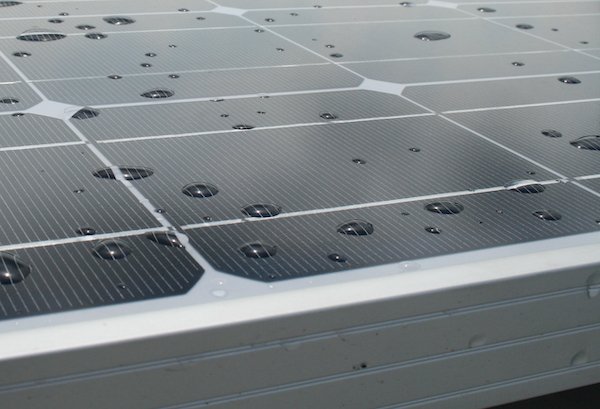
The rain-prone US state of Washington has been a little slow on the draw when the topic turns to solar panels, but that is all about to change. The state is announcing its first ever public lands lease for a solar farm, and it’s a doozy: more than 500,000 solar panels are slated for the new 150 megawatt Lund Hill project, which will cover both private and public lands in Klickitat County.
That’s a significant development in the US solar market because Klickitat County is not exactly a prime location for US solar conversion. While not the rainiest county in the US, it ranges far afield from counties in optimal PV performance states like Arizona. On average, Klickitat County experiences some kind of precipitation 100 days each year.
Solar Panels Making More Sense In More Of The US
Aside from rainy weather, solar developers in Washington have to contend with competition from other renewables in the state, including legacy hydropower operations and a thriving new wind power sector.
Nevertheless, our friends over at The Seattle Times point out that favorable economic winds are blowing over the PV sector in Washington State. Please support your friendly neighborhood journalist and follow that link for many fascinating details.
For those of you on the go, the gist of it is that “energy-guzzling” data centers in Washington State are providing the economic incentive for more PV development. That would include notables like Microsoft, Facebook, and Google among others.
Another interesting angle is complimentarity between wind and solar resources. That’s fancyspeak for the idea that wind and solar output can be managed within a grid to provide for reliable delivery without the need for excessive investment in energy storage facilities.
The Lund Hill project also fits in with the emerging PV trend in Alaska, which just hit the CleanTechnica radar last week. On first look, Alaska would appear to be the least friendly state for solar panels in the US, but its solar resource profile is similar to that of PV-friendly Germany.
Other US states with sub-optimal solar profiles are also hopping on the bandwagon. To cite just one example, a 2012 study that laid the ground for a 100% renewable energy future in Minnesota is on its way to realization. The state’s newly minted governor anticipates a big assist from the major utility Xcel, which recently announced an ambitious renewable energy plan of its own.
First Solar Panels On Public Lands In Washington
So, here’s where it gets interesting. Washington State has a longstanding lease program for commercial activities on its public lands. That currently includes more than a dozen wind farms as well as oil and gas exploration and agricultural operations.
Until the new Lund Hill project, the state’s Department of Natural Resources had no solar farms under its lease belt. A few years ago it put out a feeler:
DNR is interested in solar power generation on state trust lands. Although there are currently no solar installations on state trust lands, we are working to identify lands with high solar capacity. Please contact us if you have a proposal for a feasible solar power project on state lands.
Apparently the US company Avangrid answered the call through its subsidiary Aurora Solar (for the record, Avangrid is under the Ibderola S.A. umbrella). The result is the new Lund Hill project in Klickitat County.
An official announcement about the new lease is forthcoming. Meanwhile, earlier this year our friends over at the White Salmon Enterprise noted the scope of the project:
What would be Washington’s largest solar energy installation by a magnitude of more than five is being planned for a 1,700-acre site near Bickleton.
Aurora Solar, LLC, a wholly owned subsidiary of Avangrid Renewables, LLC, is proposing to develop a 150-megawatt solar energy facility on mostly leased private property located about eight miles south of Bickleton.
One section of land Avangrid/Aurora want to include in the siting area is owned by the Washington Department of Natural Resources…
By way of comparison, the next largest solar farm in Washington is a 28 megawatt facility in Adams County that just went into operation last December, so its fame was rather fleeting.
The Enterprise has plenty more on the Lund Hill project so follow this link for more details on the new PV project.
CleanTechnica is also reaching out to Avangrid for some insights regarding the role of the public land lease on making the Lund Hill project happen, so stay tuned for more on that.
Speaking of Avangrid, the company is well known as a wind developer in the Pacific Northwest, and it is on its way to doing the same for PV farms, too.
Last December, the Goldendale Sentinel reported that in addition to the Aurora subsidiary, Avangrid also set up a company called Bakeoven Solar, which is proposing a new PV + storage facility that would include more than 300 megawatts’ worth of solar panels and 100 megawatts of storage in Wasco County, Oregon.
That would certainly dwarf the next-biggest solar facility in the state, which weighs in at 56 megawatts.
Bakeoven’s claim to the largest collection of solar panels in the Pacific Northwest might not last for long. Rumor has it that a $1 billion, 600-megawatt PV farm is on the boards for the relatively sunny eastern part of Oregon, courtesy of Obsidian Renewables.
If you have any more news about that, drop us a note in the comment thread.
Meanwhile, coal consumption in Washington and Oregon is already far outpaced by hydropower, and it looks like the new solar activity could tip the balance even farther. Keeping in mind that all these new solar panels are coming to two states that don’t exactly lead the nation in PV development, it looks like the best is yet to come.
